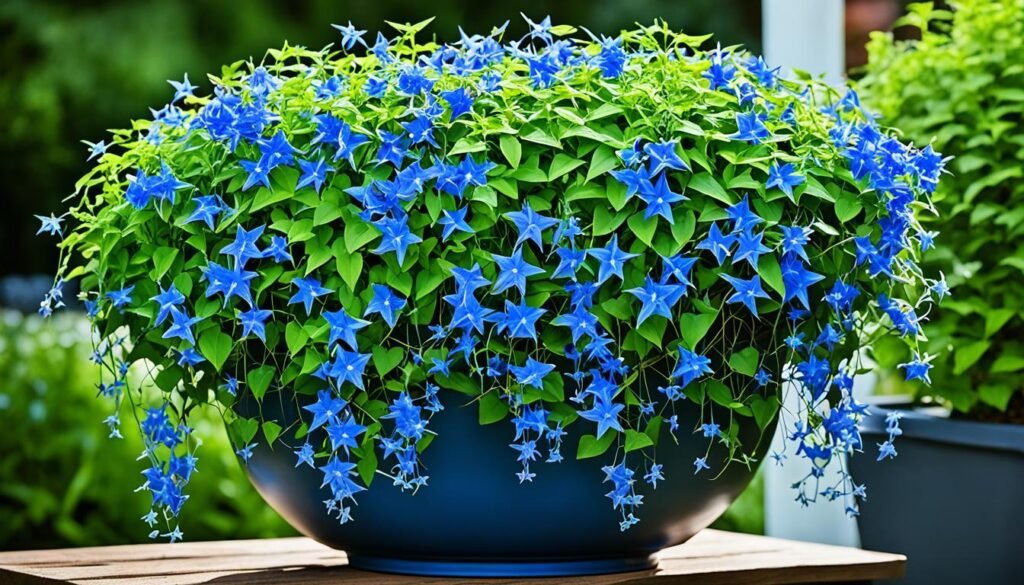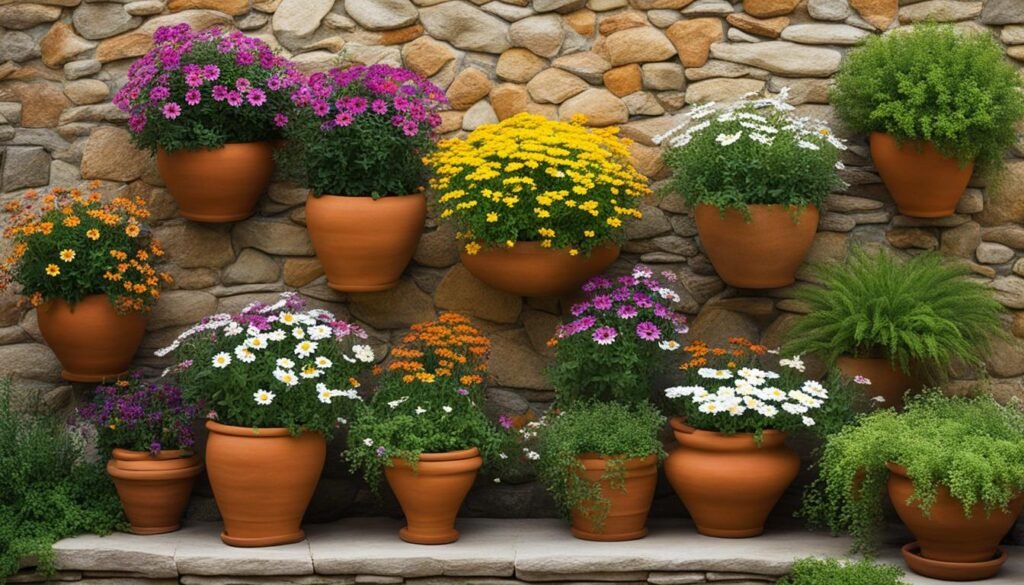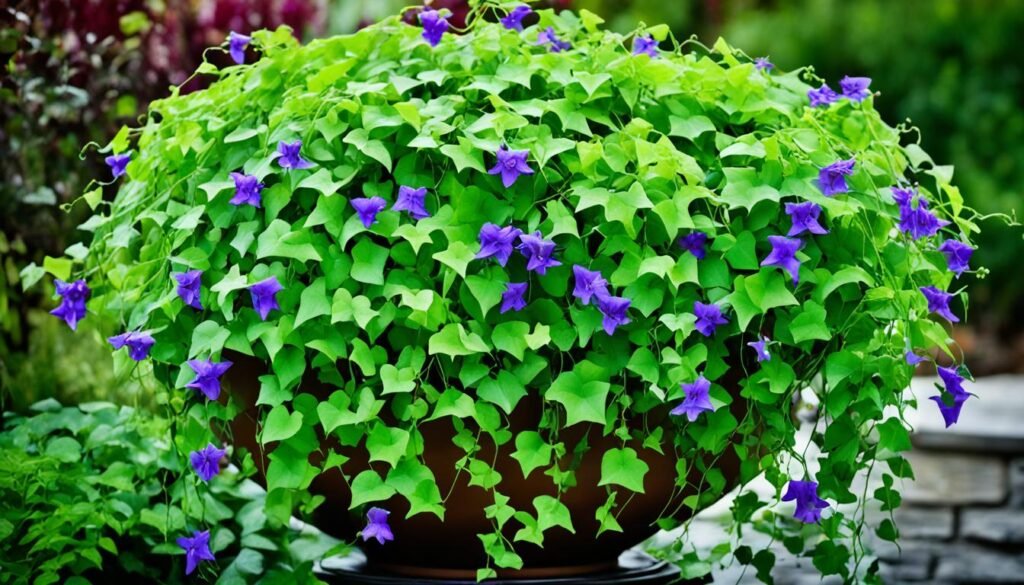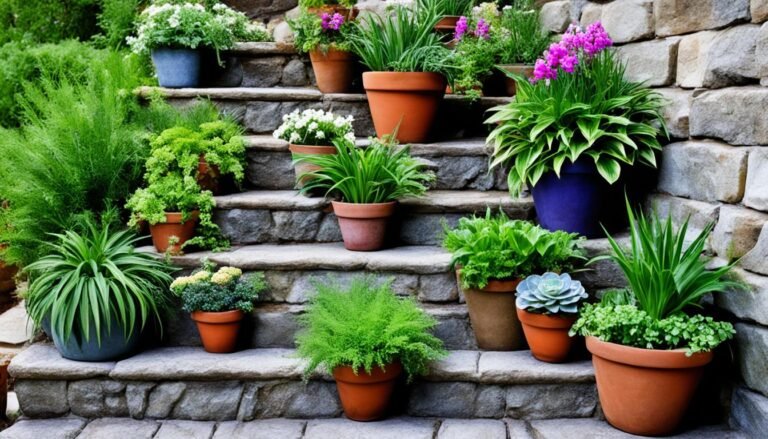Have you ever walked through a garden and been captivated by the stunning display of plants cascading down from pots and containers? I certainly have. It’s like nature’s way of creating a masterpiece, with each plant delicately spilling over the edges and adding a touch of beauty.
One sunny afternoon, as I wandered through my neighbor’s garden, I was mesmerized by the vibrant colors and textures of the cascading plants in her pots. The licorice plant gracefully tumbled over the sides, creating a soft and velvety backdrop for the other flowers. It was the perfect addition, adding depth and visual interest to the container display.
As we chatted about her secret to creating such breathtaking containers, she shared with me her love for spiller plants. These trailing wonders, also known as cascading plants, create a professional and finished look in any garden. They soften the edges of the pots and add a touch of elegance to the overall design.
She explained that combining spiller plants with thriller flowers creates a harmonious balance in the container garden. The thrillers grab your attention with their bold and eye-catching blooms, while the cascading plants provide a beautiful frame and texture, creating a full and captivating display.
Curious to know more, I delved into the world of cascading plants for pots and discovered a variety of options to choose from. From the delicate blooms of the sweet alyssum to the vibrant foliage of Joseph’s Coat, there is a cascading plant that suits every style and preference.
Whether you have a balcony garden or a spacious backyard, incorporating cascading plants in your pots will elevate the beauty of your space. So, let’s dive in and explore some of the best cascading plants for pots according to various sources.
Key Takeaways:
- Spiller plants, also known as cascading plants, add texture, color, and visual interest to container gardens.
- Combining spiller plants with thriller flowers in a container creates a full and beautiful display.
- The licorice plant is a spiller plant with small, felt-like leaves in a soft blue-gray color, ideal for pots and hanging containers.
- Joseph’s Coat is a spiller plant with small, colorful leaves that will trail and cover a container with charm.
- Sweet alyssum gently flows over the top of a container and has a wonderful honey-like scent.
Licorice Plant (Helichrysum petiolare)
The licorice plant is a spiller plant that has small, felt-like leaves in a soft blue-gray color. It can create a lovely backdrop and frame for other plants in a container garden. It grows upward and tumbles down, making it ideal for pots and hanging containers.
The licorice plant thrives in full sun and well-drained soil.
| Plant Name | Botanical Name | Leaf Color | Preferred Growing Conditions |
|---|---|---|---|
| Licorice Plant | Helichrysum petiolare | Soft blue-gray | Full sun, well-drained soil |
Joseph’s Coat (Alternanthera dentata)
Joseph’s Coat is a beautiful and versatile spiller plant that will add a pop of color and texture to your container garden. With its small, colorful leaves, Joseph’s Coat will trail and cover a container with charm, creating a stunning focal point.
This foliage plant requires minimal care and will look great all season long. Whether you choose vibrant red, yellow, or orange varieties, Joseph’s Coat will bring life and vibrancy to your pots.
Joseph’s Coat thrives in full sun, making it an excellent choice for sunny locations in your garden. It also prefers moist, well-drained soil with a neutral to acidic pH. With the right conditions, this trailing plant will flourish and provide a lush cascade of foliage for your pots.
If you’re looking for a cascading plant that adds both beauty and interest to your container arrangements, Joseph’s Coat is a fantastic option.
Key features of Joseph’s Coat:
- Spiller plant with small, colorful leaves
- Trails and covers containers with charm
- Requires minimal care and looks good all season
- Thrives in full sun and moist, well-drained soil
- Provides a stunning cascade of foliage

Joseph’s Coat is the perfect choice for those looking to add a touch of color and drama to their container gardens. Its trailing habit and vibrant leaves make it a standout addition to any pot or hanging basket.
Sweet Alyssum (Alyssum maritimum)
Sweet alyssum is a spiller plant that prefers cool weather but can still bloom in a container with regular watering. It gently flows over the top of a container and has a wonderful honey-like scent. It thrives in full or partial sun and moist, well-drained soil with a neutral to acidic pH.
Adding sweet alyssum to your container gardens will create a delicate and fragrant trailing effect. Its dainty flowers in shades of white, pink, and purple will contrast beautifully with other bold, upright plants in the container. The attractive fragrance will also add a delightful sensory experience to your outdoor space.
| Plant Name | Botanical Name | Light Requirements | Soil Conditions |
|---|---|---|---|
| Sweet Alyssum | Alyssum maritimum | Full or partial sun | Moist, well-drained soil with a neutral to acidic pH |
Image:
Trailing Snapdragon (Asarina procumbens)
The trailing snapdragon, also known as creeping snapdragon, is a short vine that tumbles out of a container and ensnares itself in nearby plants. With its charming tubular flowers resembling snapdragons, this cascading plant adds a touch of elegance to any pot or hanging container arrangement.
This versatile plant thrives in a variety of growing conditions, but it prefers full sun to partial shade. Providing rich, well-drained loam soil with a neutral to acidic pH will ensure optimal growth and blooming.

Key Features of Trailing Snapdragon:
- Trails gracefully out of pots and containers
- Ensnaring habit adds visual interest and texture
- Tubular flowers resemble traditional snapdragons
- Adaptable to a variety of growing conditions
- Thrives in full sun to partial shade
- Requires rich, well-drained loam soil with a neutral to acidic pH
“The trailing snapdragon brings a unique touch to container gardens, draping over the sides and creating a captivating display.” – Gardening Enthusiast
Bidens (Bidens ferulifolia)
Bidens plants, also known as Bidens ferulifolia, are a perfect choice for cascading plants in pots. These beautiful and versatile plants feature small, daisy-like flowers in vibrant shades of yellow, pink, white, and orange. With their trailing growth habit, Bidens gracefully drape over the sides of containers, adding a touch of elegance to any garden.
One of the exceptional qualities of Bidens is their exceptional heat and drought tolerance. They can thrive even in challenging climates, making them an excellent choice for those seeking low-maintenance plants. Whether you live in a hot and arid region or simply prefer plants that can withstand dry spells, Bidens will not disappoint.
Bidens plants are highly adaptable and thrive in full sun. They require well-drained soil with a neutral to slightly acidic pH. By providing them with the right conditions, you can enjoy their stunning blooms throughout the season.
“Bidens plants are a delightful addition to any pot or container garden. Their trailing growth and vibrant flowers add a burst of color and texture, creating an eye-catching display. Plus, with their heat and drought tolerance, Bidens plants are a reliable choice for any gardener.”
Here is a visual representation of the beautiful Bidens plant:

| Common Name | Scientific Name | Flower Colors | Growth Habit | Light Requirements | Soil Requirements |
|---|---|---|---|---|---|
| Bidens | Bidens ferulifolia | Yellow, Pink, White, Orange | Trailing | Full Sun | Well-drained soil, neutral to slightly acidic pH |
As shown in the table, Bidens plants offer a beautiful range of flower colors, a trailing growth habit, and thrive in full sun. Ensure you provide them with well-drained soil and a slightly acidic pH for optimal growth.
With Bidens plants in your pot or container garden, you can create a stunning cascade of colors and bring life to any space.
Blue Star Creeper (Laurentia axillaris)
Blue Star Creeper is a spiller plant that forms a froth of finely cut foliage with lavender-blue, star-shaped flowers. It adapts to various growing conditions and blooms repeatedly. It thrives in full to partial sun and moist, well-drained soil with a neutral to acidic pH.

“The delicate lavender-blue flowers of Blue Star Creeper add a touch of elegance to any container. It gracefully cascades down the sides, creating a soft carpet of color,” says gardening expert Sarah Thompson.
If you’re looking for a versatile and low-maintenance trailing plant for your pots, Blue Star Creeper is an excellent choice. With its delicate foliage and beautiful flowers, it brings a sense of charm and grace to any container garden. Whether you have full sun or partial shade, this cascading plant will adapt and thrive, adding a stunning visual element to your outdoor space.
Key Features of Blue Star Creeper:
- Spiller plant with finely cut foliage
- Lavender-blue, star-shaped flowers
- Adapts to various growing conditions
- Blooms repeatedly
- Thrives in full to partial sun
- Requires moist, well-drained soil with a neutral to acidic pH
Swan River Daisy (Brachycome)
Swan River Daisy is a spiller plant with daisy-like flowers in purple, blue, and white. The lacy green foliage of this plant is as attractive as its flowers. As the plant gets top-heavy with flowers, it spills over the sides of a container. It thrives in full sun and well-drained soil with a neutral pH.

Calibrachoa
Calibrachoa, also known as Million Bells, is a versatile and popular choice for cascading plants in pots. This trailing plant is closely related to petunias and features smaller, bell-shaped flowers that come in a wide range of vibrant colors.
One of the standout features of Calibrachoa is its prolific blooming habit. It sets a large number of flowers throughout the summer, ensuring a constant burst of color in your garden. The trailing habit of Calibrachoa adds a charming and dynamic element to your container displays, creating a cascading effect that softens the edges of pots and adds visual interest.
To keep your Calibrachoa flourishing, provide it with full sun exposure and well-drained soil. This plant thrives in fertile, loamy soil with a neutral pH level. Regular watering and occasional fertilization will help maintain its lush growth and abundant blooms.
Benefits of Calibrachoa:
- Spectacular trailing habit adds depth and dimension to container gardens.
- Large number of flowers create a stunning display throughout the summer.
- Vibrant colors bring life and vibrancy to your outdoor space.
- Low maintenance plant that requires minimal care.
- Well-suited for hanging containers, window boxes, and patio pots.
Tips for Growing Calibrachoa:
- Choose a sunny spot with well-drained soil for optimal growth.
- Water regularly to keep the soil moist but not soggy.
- Apply a balanced, slow-release fertilizer every few weeks.
- Pinch back the stems to encourage bushier growth and more flowers.
- Remove faded flowers to promote continuous blooming.
Inspiring Container Combinations:

| Container Type | Plant Combinations |
|---|---|
| Window Boxes | Calibrachoa, Sweet Alyssum, Blue Star Creeper |
| Hanging Baskets | Calibrachoa, Bidens, Trailing Snapdragon |
| Large Pots | Calibrachoa, Licorice Plant, Swan River Daisy |
Cup and Saucer Vine (Cobea)
The Cup and Saucer Vine is a stunning cascading plant that adds elegance to any garden. This graceful vine can be trained to grow up a small trellis, creating a vertical display of its beautiful foliage and flowers. Alternatively, it can be allowed to drape and circle a container, forming a cascading masterpiece of color.

The Cup and Saucer Vine gets its name from its unique and eye-catching flowers. These flowers have saucer-like bracts, which surround the cup-shaped blossoms in shades of purple, pink, or white. The combination of the bracts and flowers creates a mesmerizing display that is sure to capture attention.
In terms of care, the Cup and Saucer Vine thrives in full sun, providing it with the necessary light to stimulate healthy growth and abundant flowering. It also requires moist to well-drained soil with a neutral to acidic pH. Proper watering and regular fertilization will ensure that this trailing plant remains vigorous and vibrant.
Whether used as a focal point in a hanging container or as a trailing accent in a pot, the Cup and Saucer Vine is sure to make a statement with its cascading beauty. Its unique flowers, graceful vines, and easy-care nature make it a perfect choice for any garden enthusiast.
Conclusion
Cascading plants for pots bring a touch of natural beauty and elegance to your garden. By incorporating these trailing plants, you can create stunning displays that add depth, texture, and visual interest to your container gardens. Whether you choose the soft blue-gray foliage of the Licorice Plant, the colorful leaves of Joseph’s Coat, or the delicate blooms of Sweet Alyssum, there are numerous options to suit your personal style and preferences.
These cascading plants not only enhance the overall impact of your container displays but also create a sense of professionalism and sophistication. As they spill over the edges of pots and containers, they create a stunning visual effect, making your garden truly breathtaking. The combination of spillers and thriller flowers in a container creates a full and beautiful display that will captivate anyone who sees it.
Embracing cascading plants for pots allows you to transform your garden into a personal oasis. Whether you have a small balcony or a spacious backyard, incorporating these plants can make a big impact. So, don’t hesitate to explore the wide range of options available, from trailing snapdragons to blue star creepers, and let your creativity guide you. Create a stunning garden filled with cascading plants for pots and enjoy the beauty and tranquility they bring to your outdoor space.
